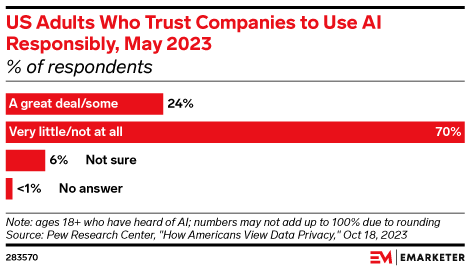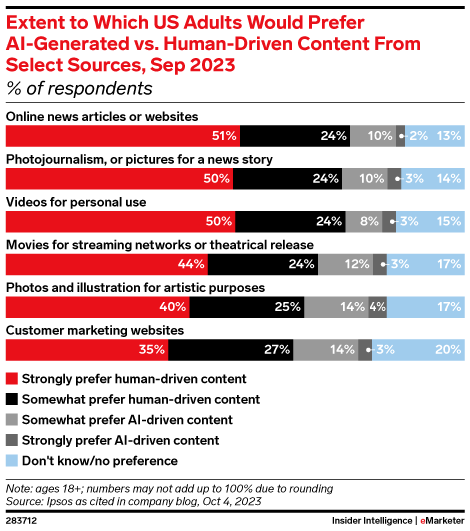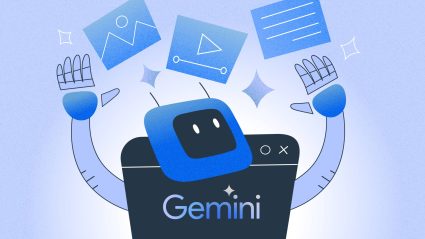Artificial intelligence (AI) is still the hot new commodity in content creation. But for every piece of “good” content generated by AI, there are plenty of “bad” pieces. That’s because a lot of marketers don’t fully understand AI’s strengths and weaknesses and how to use it.
Google’s recent March core algorithm update highlights the tension between AI-generated content and quality search results, raising concerns about spammy AI content flooding the web and hurting website rankings.
So is AI content all bad when it comes to ranking on the SERP?
It’s complicated. Google’s priority has always been rewarding content that demonstrates E-E-A-T: expertise, experience, authoritativeness, and trustworthiness. While generative AI has promise, the technology is still in its early days. For AI content to pass the E-E-A-T test and rank well under Google’s updated algorithm, it needs a little help from humans.
Rise of the robots: the need for human-centered content
As social media platforms and online marketplaces become increasingly popular places for users to look for information, Google is no longer the end-all-be-all of search. Google has been innovating to include more of the aspects that make other forms of search, like social media, so popular. One of the most important parts of that is an emphasis on authentic, human content.
The platform has made a big push to include social, video, and perspective-based content in their results. Initiatives like the new dedicated “Short Videos” section Google is testing, which features YouTube and TikTok videos, attempt to harness some of the power of social media search.
In this climate, prioritizing high-quality, human-centered content is vital for Google to maintain users’ trust in their search platform. The most recent core update has made that importance clear: it enhances the algorithm to reduce content Google registers as spammy or low-quality and give users a better search experience.
The human or “experience” element of a brand’s content will become an even more critical differentiating factor moving forward. That makes AI-produced website materials a sticking point, since the technology can sometimes produce low-quality content that doesn’t rank well in the algorithm or connect with users.
AI content also faces pushback from many consumers who are skeptical of AI and the companies serving it to them; 70% of US adults trust companies to use AI responsibly very little or not at all, according to a poll from the Pew Research Center.

Source: eMarketer
As AI content saturates the market, that skepticism has grown. People are questioning the truth, originality, and purpose of what they read online more than ever.
AI content the right way: focus on the human experience
With so much reluctance from users and the recent and upcoming changes to Google’s algorithm, can brands still use AI tools for website content without damaging their search ranking?
The short answer is yes–but only if they continue building helpful, unique content experiences for site visitors. That great content will help you rank on the SERP and will be the foundation for results that get pulled into the new SGE, Gemini, and other AI-powered search experiences.
Making amazing site copy, images, and video for your website can include using AI tools as long as you’re careful about how you leverage the technology. Right now, the strongest use case for AI is as a creative co-pilot.
Think of AI as your helpful assistant: it’s not creating the work on its own, but it can do a lot to speed up the process. When using AI to ideate, optimize, or even generate content, it’s important to keep some guidelines in mind:
- Don’t let AI replace human ingenuity: While AI can streamline the development of imagery, videos, content, and code, human expertise is critical for refining assets, ensuring they’re impactful, error-free, and aligned with brand goals. You should make sure any AI materials are reviewed by your team and that you’re still putting in the effort to be original.
- Fact-checking is a must: AI tools can make mistakes, like how some AI models “hallucinate” false information in responses. You’re ultimately responsible for ensuring everything is accurate before publishing, so check any facts produced by AI tools carefully.
- Originality is key: Infuse your brand’s unique voice, perspective, and insights in content pieces. Avoid sounding generic or rehashing what AI produces verbatim.
It’s also important to find the right AI tools to meet your team’s goals. Take the time to explore and test different options to find the best ones for you.
Once you’ve invested in AI tools that complement your workflow, you can use them to power everything from data and market research to briefing, ideation, copywriting, and spec work. Your team can then reinvest time and energy into creative research and strategy to make your future content even better.
If you follow these best practices, your AI-assisted content will still meet Google’s E-E-A-T standards, so you can rank highly without sacrificing the innovation or efficiency AI tools provide.
The future is bright (and human): finding the balance
Remember, while AI is a powerful tool, it can’t replicate the creativity, empathy, and critical thinking that are uniquely human. Users can tell when AI is being used without proper oversight, and that can damage your relationship with your customers over time.
Many Americans are very resistant to the idea of AI creating the writing, images, or videos they consume. According to Ipsos, consumers overwhelmingly prefer human-driven content to AI-driven content.

Source: eMarketer
That doesn’t mean you should forego using AI entirely. Instead, brands need to be careful about where they employ AI and how they communicate with their customers about technology. Transparency about how you create your content is crucial to gaining and keeping trust.
Being clear about the way you use AI and making sure the content you produce is still high-quality will also improve your search ranking. Beyond avoiding the negative impact of having your content flagged as low-quality, having good content pays dividends for the factors that Google considers when ranking sites: users spending more time on your website and other trusted websites linking back to your site will help you organically rise in the ranks.
It’s a challenge to walk the line between innovation and quality that will optimize your site for today’s Google. But if you strike the right balance between AI-driven and human-led, you can create content that not only ranks well on the SERP but truly resonates with your audience.
Now that you know the kind of content that ranks, prepare your strategy for AI’s role in search with our full guide.







Responses